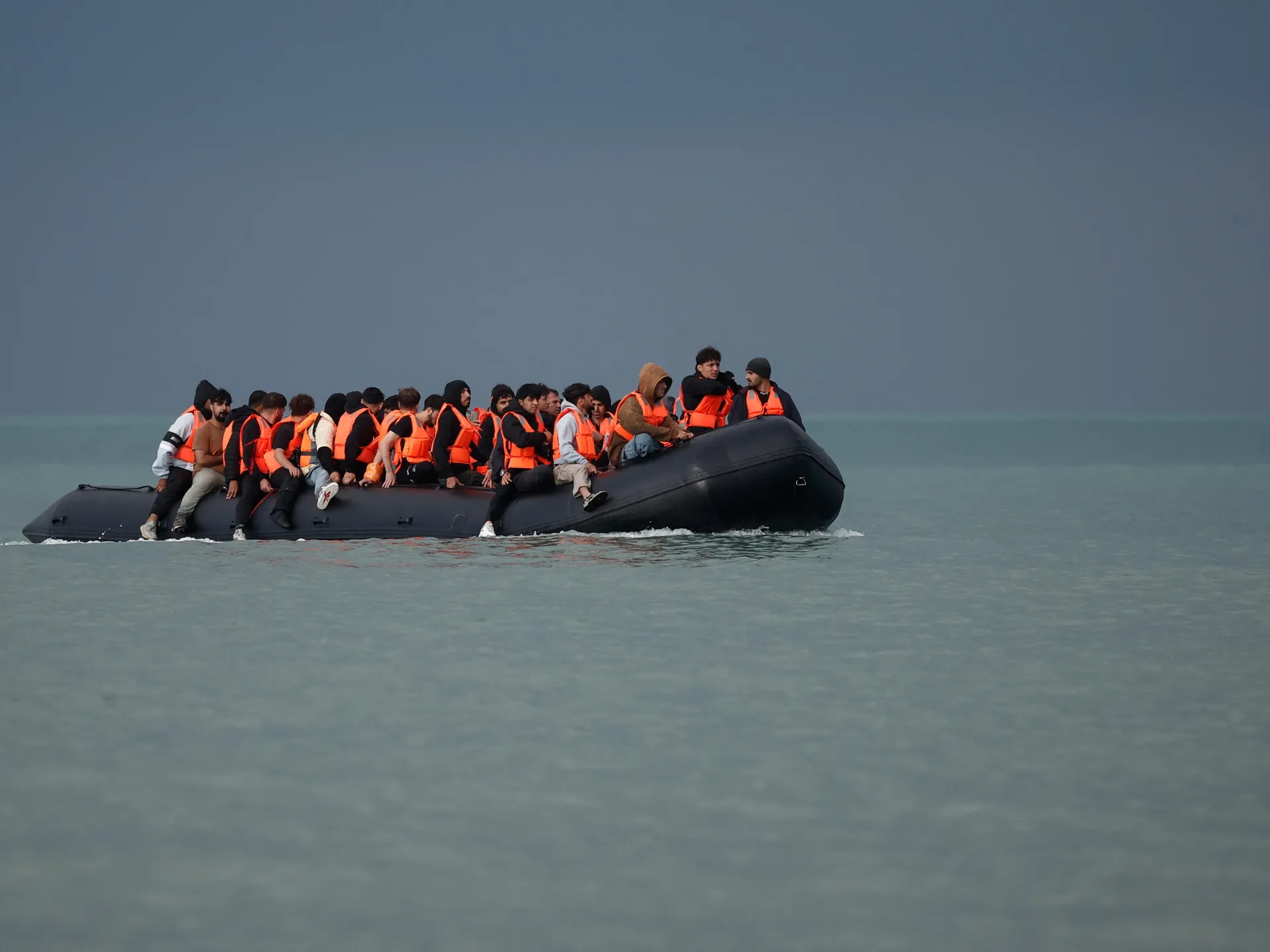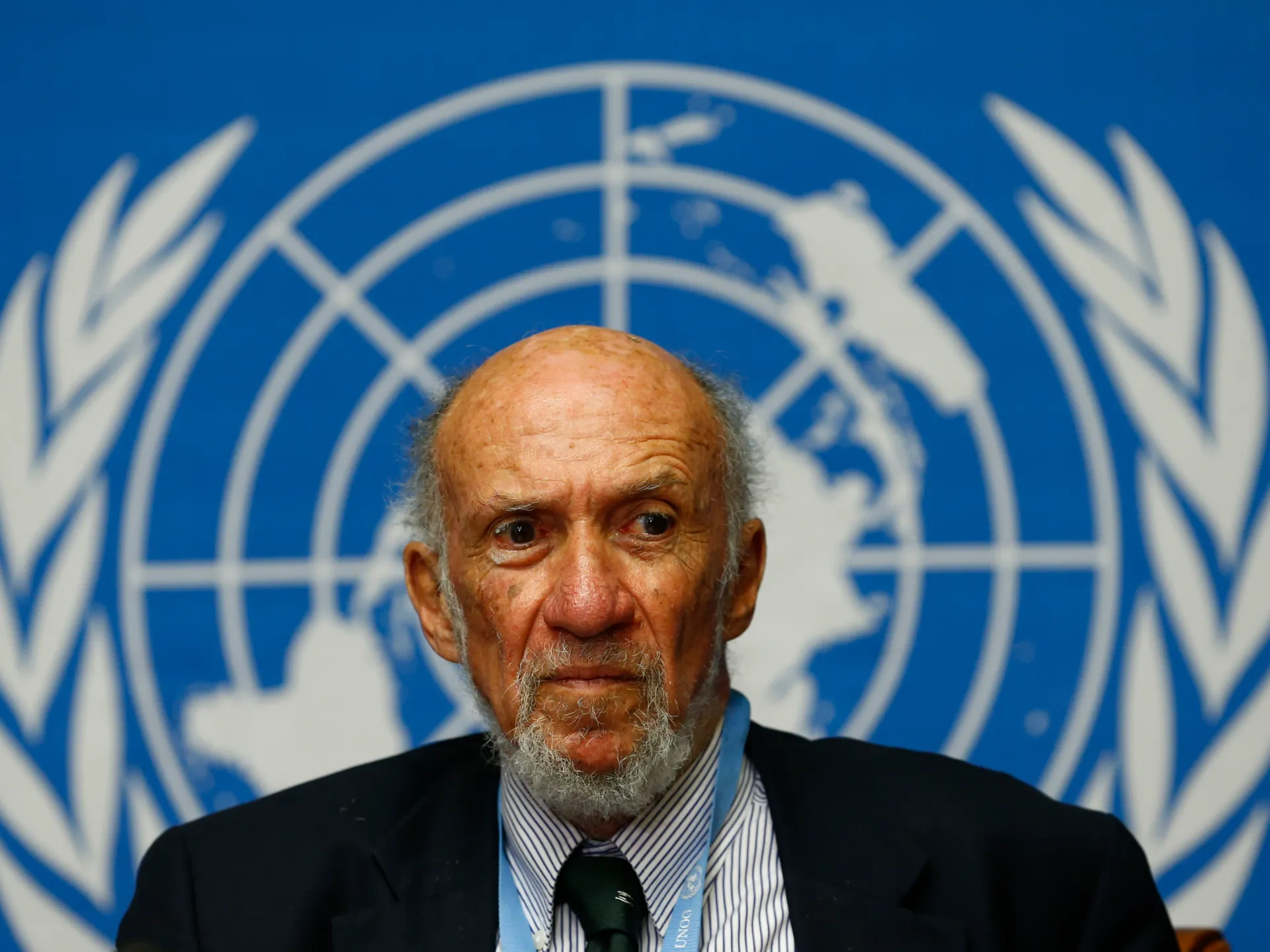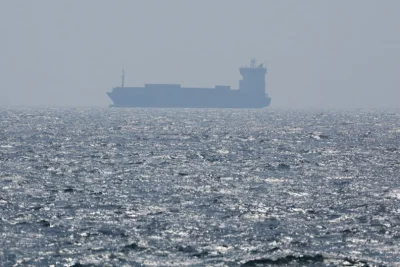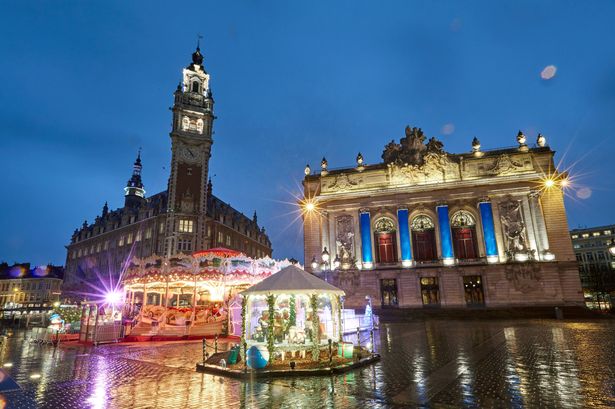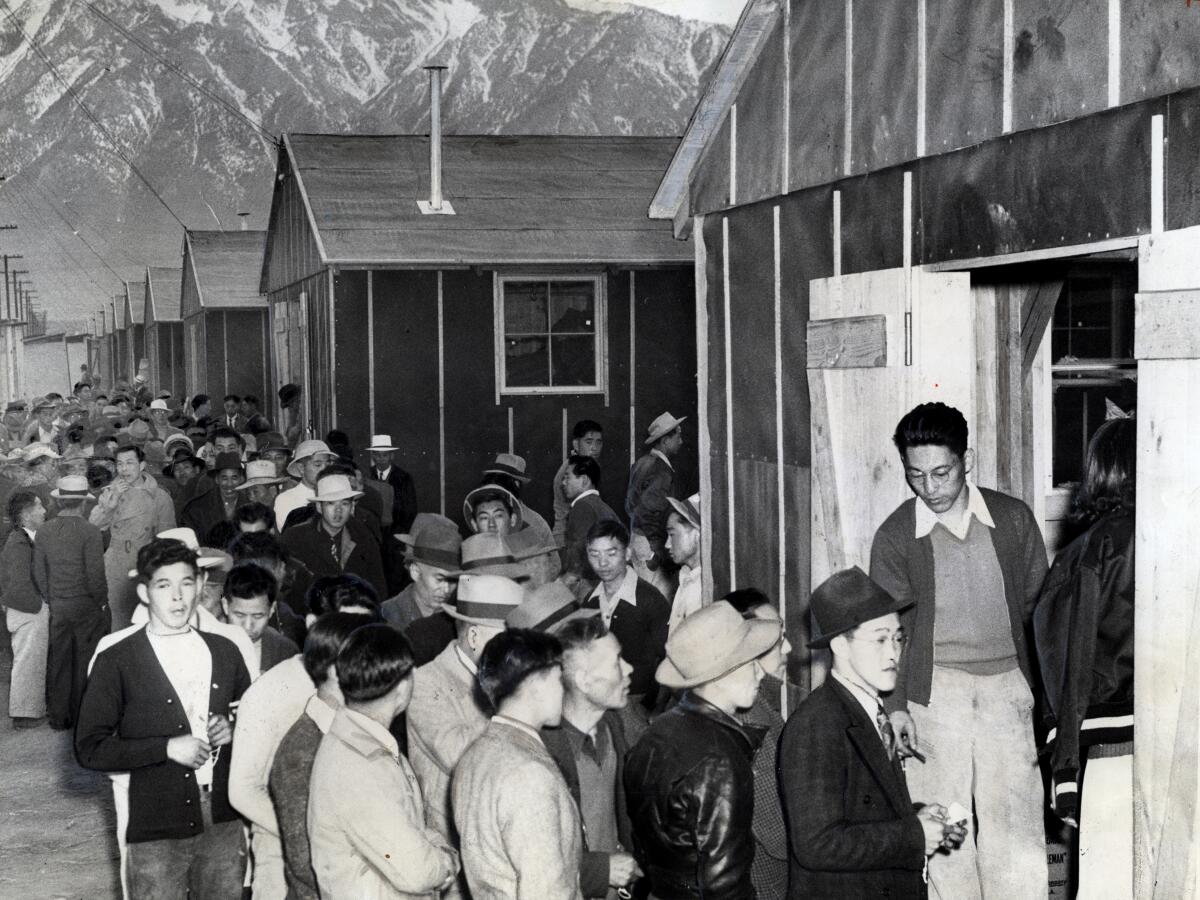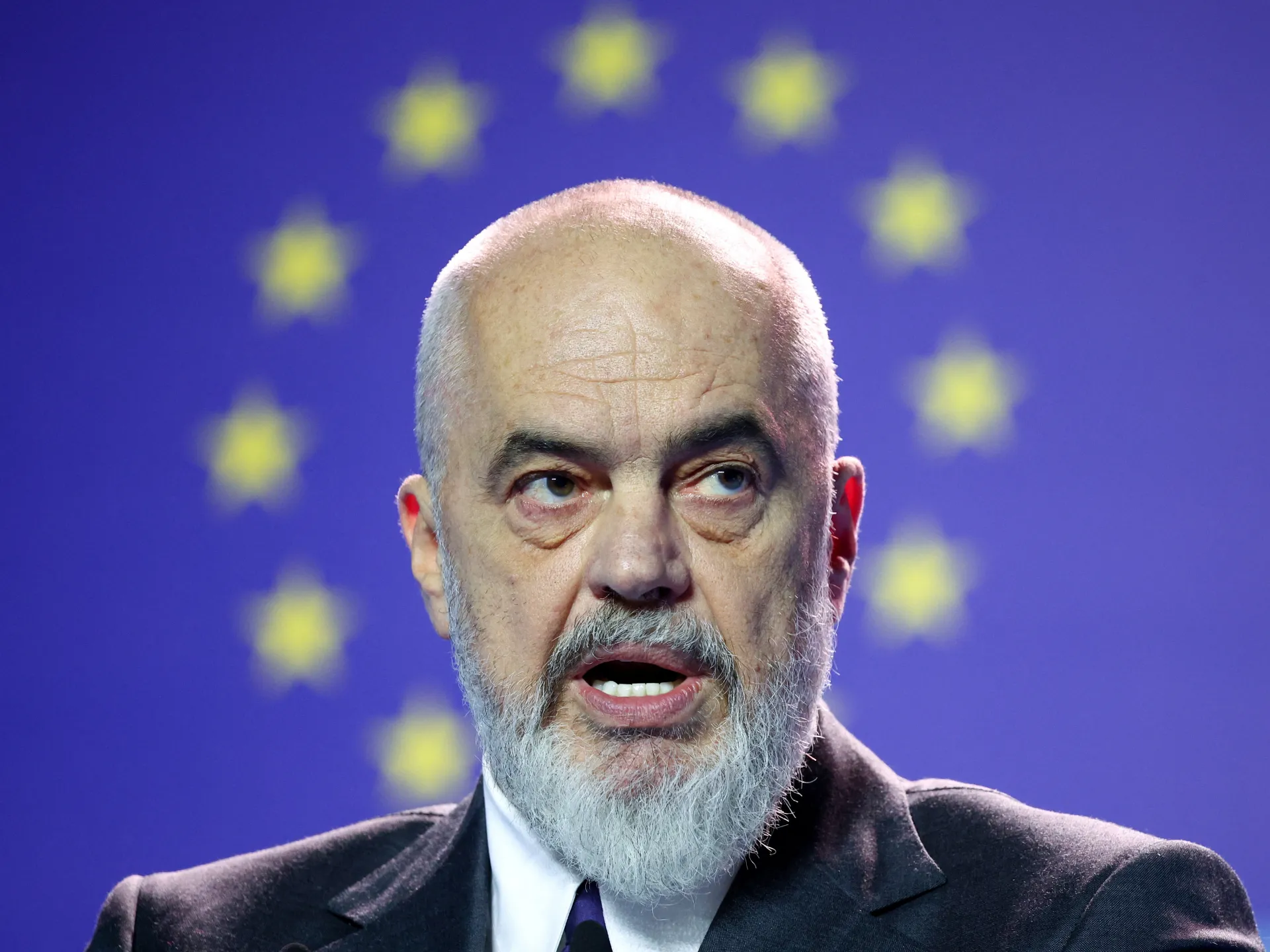Supreme Court’s conservatives face a test of their own in judging Trump’s tariffs
WASHINGTON — The Supreme Court’s conservatives face a test of their own making this week as they decide whether President Trump had the legal authority to impose tariffs on imports from nations across the globe.
At issue are import taxes that are paid by American businesses and consumers.
Small-business owners had sued, including a maker of “learning toys” in Illinois and a New York importer of wines and spirits. They said Trump’s ever-changing tariffs had severely disrupted their businesses, and they won rulings declaring the president had exceeded his authority.
On Wednesday, the justices will hear their first major challenge to Trump’s claims of unilateral executive power. And the outcome is likely to turn on three doctrines that have been championed by the court’s conservatives.
First, they say the Constitution should be interpreted based on its original meaning. Its opening words say: “All legislative powers … shall be vested” in Congress, and the elected representatives “shall have the power to lay and collect taxes, duties, imposes and excises.”
Second, they believe the laws passed by Congress should be interpreted based on their words. They call this “textualism,” which rejects a more liberal and open-ended approach that included the general purpose of the law.
Trump and his lawyers say his sweeping “Liberation Day” tariffs were authorized by the International Economic Emergency Powers Act, or IEEPA.
That 1977 law says the president may declare a national emergency to “deal with any unusual and extraordinary threat” involving national security, foreign policy or the economy of the United States. Faced with such an emergency, he may “investigate, block … or regulate” the “importation or exportation” of any property.
Trump said the nation’s “persistent” balance of payments deficit over five decades was such an “unusual and extraordinary threat.”
In the past, the law has been used to impose sanctions or freeze the assets of Iran, Syria and North Korea or groups of terrorists. It does not use the words “tariffs” or “duties,” and it had not been used for tariffs prior to this year.
The third doctrine arose with Chief Justice John G. Roberts Jr. and is called the “major questions” doctrine.
He and the five other conservatives said they were skeptical of far-reaching and costly regulations issued by the Obama and Biden administrations involving matters such as climate change, student loan forgiveness or mandatory COVID-19 vaccinations for 84 million Americans.
Congress makes the laws, not federal regulators, they said in West Virginia vs. Environmental Protection Agency in 2022.
And unless there is a “clear congressional authorization,” Roberts said the court will not uphold assertions of “extravagant statutory power over the national economy.”
Now all three doctrines are before the justices, since the lower courts relied on them in ruling against Trump.
No one disputes that the president could impose sweeping worldwide tariffs if he had sought and won approval from the Republican-controlled Congress. However, he insisted the power was his alone.
In a social media post, Trump called the case on tariffs “one of the most important in the History of the Country. If a President is not allowed to use Tariffs, we will be at a major disadvantage against all other Countries throughout the World, especially the ‘Majors.’ In a true sense, we would be defenseless! Tariffs have brought us Great Wealth and National Security in the nine months that I have had the Honor to serve as President.”
Solicitor Gen. D. John Sauer, his top courtroom attorney, argues that tariffs involve foreign affairs and national security. And if so, the court should defer to the president.
“IEEPA authorizes the imposition of regulatory tariffs on foreign imports to deal with foreign threats — which crucially differ from domestic taxation,” he wrote last month.
For the same reason, “the major questions doctrine … does not apply here,” he said. It is limited to domestic matters, not foreign affairs, he argued.
Justice Brett M. Kavanaugh has sounded the same note in the past.
Sauer will also seek to persuade the court that the word “regulate” imports includes imposing tariffs.
The challengers are supported by prominent conservatives, including Stanford law professor Michael McConnell.
In 2001, he and John Roberts were nominated for a federal appeals court at the same time by President George W. Bush, and he later served with now-Justice Neil M. Gorsuch on the U.S. 10th Circuit Court of Appeals in Denver.
He is the lead counsel for one group of small-business owners.
“This case is what the American Revolution was all about. A tax wasn’t legitimate unless it was imposed by the people’s representatives,” McConnell said. “The president has no power to impose taxes on American citizens without Congress.”
His brief argues that Trump is claiming a power unlike any in American history.
“Until the 1900s, Congress exercised its tariff power directly, and every delegation since has been explicit and strictly limited,” he wrote in Trump vs. V.O.S. Selections. “Here, the government contends that the President may impose tariffs on the American people whenever he wants, at any rate he wants, for any countries and products he wants, for as long as he wants — simply by declaring longstanding U.S. trade deficits a national ‘emergency’ and an ‘unusual and extraordinary threat,’ declarations the government tells us are unreviewable. The president can even change his mind tomorrow and back again the day after that.”
He said the “major questions” doctrine fully applies here.
Two years ago, he noted the court called Biden’s proposed student loan forgiveness “staggering by any measure” because it could cost more than $430 billion. By comparison, he said, the Tax Foundation estimated that Trump’s tariffs will impose $1.7 trillion in new taxes on Americans by 2035.
The case figures to be a major test of whether the Roberts court will put any legal limits on Trump’s powers as president.
But the outcome will not be the final word on tariffs. Administration officials have said that if they lose, they will seek to impose them under other federal laws that involve national security.
Still pending before the court is an emergency appeal testing the president’s power to send National Guard troops to American cities over the objection of the governor and local officials.
Last week, the court asked for further briefs on the Militia Act of 1908, which says the president may call up the National Guard if he cannot “with the regular forces … execute the laws of the United States.”
The government had assumed the regular forces were the police and federal agents, but a law professor said the regular forces in the original law referred to the military.
The justices asked for a clarification from both sides by Nov. 17.
Why the 2026 World Cup may not help American soccer leagues surge
Remember when soccer was being touted as the next big sport in the U.S.? Well, it looks like that moment has finally arrived.
Or not. It all depends on who you ask and how you interpret what they tell you.
On one hand, there’s the recent Harris Poll that found 72% of Americans profess an interest in soccer, a 17% increase from 2020. A quarter of those are “dedicated” fans and 1 in 5 say they are “obsessed” with the sport.
On the other hand, there’s the stark decline in attendance and TV viewership for the country’s top two domestic leagues, MLS and the NWSL, and the underwhelming crowds that showed up last summer for the FIFA Club World Cup and the CONCACAF Gold Cup.
LAFC fans lift up a banner honoring Carlos Vela during a ceremony to honor him before a match against Real Salt Lake at BMO Stadium on Sept. 21.
(Kevork Djansezian / Getty Images)
These contrary findings — a growing fanbase at the same time attendance and viewership numbers are falling off a cliff — come at an important inflection point for soccer in the U.S., with the largest, most ambitious World Cup kicking off at SoFi Stadium in fewer than 200 days.
“The short answer is yes, the World Cup will be a watershed moment for soccer in America. However, it’s unlikely to immediately lead to a significant increase in ticket sales for MLS and NWSL. Soccer fandom in America develops differently from that of other sports,” said Darin W. White, executive director of the Sports Industry Program and the Center for Sports Analytics at Samford University, which next year will launch a major five-year study to explore how soccer can become mainstream in the U.S.
“The World Cup will bring millions of new Americans into the pipeline. Over the next few years we expect these new fans to progress through the pipeline, giving soccer a substantial enough fan base to tip the scales and help make soccer part of the ongoing mainstream sports conversation. I am confident that the World Cup will enable soccer to reach that critical mass.”
Steven A. Bank, a professor of business law at UCLA who has written and lectured extensively on the economics of soccer, isn’t as optimistic.
“The risk isn’t that U.S. soccer will be in the same place in 10 years, but that it will have regressed,” he said.
“For the World Cup to benefit domestic leagues’ attendance, ratings, and revenue, as well as youth and adult participation rates in playing soccer, it will have to be the catalyst for more domestic investment in the game. The question isn’t whether the World Cup will convince enough people to become fans or to move from casual to dedicated or obsessive fans. It’s whether it will convince enough wealthy people and companies to risk the kind of money necessary to compete with the top leagues for the top talent.”
U.S. captain Christian Pulisic drives the ball during an international friendly against Ecuador at Q2 Stadium on Oct. 10 in Austin, Texas.
(Omar Vega / Getty Images)
That investment could be a boost to both first-tier domestic leagues, which saw their attendance and TV rating fall dramatically this year. After setting records in both 2023 and ‘24, MLS watched its average attendance fall 5.4% — to 21,988 fans per match — this season. According to Soccer America, 19 of the 29 teams that played in 2024 saw their attendance drop; more than half saw declines of 10% or more.
The TV audience also appears to be relatively small, although the fact Apple TV, the league’s main broadcast partner, rarely releases viewer data has hampered efforts to draw any firm conclusions. MLS said last month that its games attracted 3.7 million global aggregate viewers a week on all its streaming and linear platforms, an average of about 246,000 a game on a full weekend. While that’s up nearly 29% from last year, the average viewership figure is about 100,000 smaller than what the league drew for single games on ESPN alone in 2022, the last season before Apple’s 10-year $2.5-billion took effect.
NWSL also saw overall league attendance fall more than 5%, with eight of the 13 teams that played in 2024 experiencing declines. And TV viewership in the second year of the league’s four-season $240 million broadcast deal was down 8% before the midseason July break, according to the Sports Business Journal.
That follows a summer in which both the expanded Club World Cup and the Gold Cup struggled to find an audience. Although the 63-match Club World Cup drew an average of 39,547 fans per game, 14 matches had crowds of fewer than 20,000. The Gold Cup averaged 25,129 for its 31 games — a drop of more than 7,000 from 2023. And five matches drew less than 7,800 people.
“There’s a danger of taking this year’s decline out of context,” said Stefan Szymanski, a professor of sports management at the University of Michigan and author of several books on soccer including “Money and Soccer” and “Soccernomics” (with Simon Kuper). “Last year was a record year. It’s really about the diminishment of the Messi effect.
“I wouldn’t say it’s a moment of crisis. And the way MLS is looking at this strikes me that they’re entirely focused on a post-World Cup [bump], which they think they’re going to get. I’d be skeptical myself about that. I don’t think it will do that much for them.”
Szymanski said the World Cup could hurt the league by underscoring the huge difference in the quality of play between elite international soccer and MLS.
“Americans are not dumb,” he said. “They know what’s good quality sport [and] not good quality sport. And they know that MLS is low level. The only way, in a global marketplace, you can get the top talent to have a truly competitive league is to pay the salaries.”
Which brings us back to Bank’s conclusion that fixing soccer in the U.S. isn’t about the soccer, it’s about the money being spent on the sport. For next summer’s World Cup to have a lasting impact, the “bump” will have to come not just from an increase in attendance and TV viewership but in investment as well. And, as Szymanski argues, that means additional investment in players as well.
“If all it does is attract eyeballs for this competition,” Bank said “I’m not sure it does more than the Olympics does every four years when it temporarily raises the profile of a few sports for some people who were not casual fans before.”
Video: Hunting Brazil’s illegal goldminers, deep in Amazon rainforest
Deep into the Amazon rainforest environmental agents are on the hunt for illegal goldminers.
Source link
Women’s World Cup qualifying draw: England paired with Spain as Scotland, Wales, Northern Ireland and Republic of Ireland learn opponents
England have been drawn with Spain in their qualifying group for the 2027 Women’s World Cup.
Spain beat the Lionesses in the 2023 World Cup final, but England gained revenge when they beat the world champions in the Euro 2025 final in July to retain their European title.
Iceland and Ukraine have also been placed in Group A3 alongside Sarina Wiegman’s side.
Qualifying for the World Cup, which will be held in Brazil, follows the same format as the Nations League and is split into three tiers.
Only the four group winners in League A will automatically qualify for the finals, with the remaining teams having to go through the play-offs for the remaining eight places.
Scotland have been paired with Belgium, Israel and Luxembourg in Group B4, while Wales will face the Czech Republic, Albania and Montenegro in Group B1.
Northern Ireland have been placed in Group B2 with Switzerland, Turkey and Malta, and the Republic of Ireland are in Group A2 alongside the Netherlands, France and Poland.
The qualifiers will be played across six matchdays, on a home and away basis, during 2026, starting on 3 March and finishing on 9 June.
Uefa has been allocated 11 places for the 32-team 2027 World Cup.
An additional European team could also qualify through Fifa’s intercontinental play-offs.
Government urged to replace annual BBC TV licence fee with ads before price rise
The annual TV licence fee is set to rise in April 2026
Calls have been made to scrap the BBC TV licence fee and introduce either advertising or a paywall system before the annual price increase in April. A new online petition has urged the Government to make changes to the TV licence system.
The current fee stands at £174.50 and households must pay this if they watch or record live television, or face potential fines. This charge usually increases alongside September’s Consumer Price Index (CPI) inflation rate, which reached 3.8 per cent.
Such a rise would push the licence fee up by £6.65 to £181.15 for the 2026/27 financial year. The Daily Record reports that this isn’t guaranteed and awaits confirmation from the UK Government later this month, typically around the Autumn Budget on November 26.
From April 1, 2024, the UK Government determined the licence fee would increase annually with CPI inflation for the Charter period’s remaining four years. The BBC’s current Charter continues until the end of 2027.
Campaigner David Gilmore contends that “even if you don’t watch the BBC you still have to pay for it”. He continued: “You don’t have to pay for content put on by theatres or cinemas if you don’t watch it so why should you be required to pay the BBC if you don’t watch their content?”
The petition titled “Scrap the BBC TV licence and replace funding with adverts or paywall” appears on the UK Government’s petitions-parliament website. At the time of reporting, it had over 1,300 signatures.
The petition needs 10,000 signatures to receive a written response and at 100,000 signatures, it would be considered for debate in Parliament. The petition can be viewed online here.
Other calls to change the TV licence
Over 15,200 people have signed a similar petition, urging the UK Government to cover the TV licence fee for all State Pensioners and those who reach the current official retirement age of 66. As per the current rules, only those over the age of 75 who are receiving Pension Credit are entitled to a free TV licence, saving them £174.50 on the annual fee.
Michael Thompson, the creator of the petition, argues that “many pensioners live on the breadline with only the TV for company”.
He further stated: “With the cost of food soaring and utility bills ever higher, we feel there is a desperate need to provide all pensioners with at least this concession.”
Mr Thompson added: “We feel it is a double outrage that those who have given their all to this country in taxes and raising children have to pay a TV licence fee and are only exempt if they receive means-tested Pension Credit. Meanwhile, some media figures draw huge salaries.”
The “Fund free TV licences for all pensioners” petition can also be seen on the UK Government’s petitions-parliament website.
You can stay in the famous Gavin and Stacey house on Trinity Street for £18 each
LAST Christmas, Gavin and Stacey was the TV show everyone was waiting for, and now there’s another autumn treat to delight fans.
But rather than just standing outside of Trinity Street when you head to Barry Island to take a look around the filming locations, you can actually book to stay inside one of the famous houses used on the show.
The home in question is called ‘Lush House’ (of course), which fans will recognise as Doris’ home used in the original series and last year’s finale.
You can now book out the entire house on Trinity Street with Sykes Cottages.
Inside you’ll find a kitchen fitted with everything you need for your stay – including a hob for whipping up one of Gwen’s signature omelettes.
There’s a cosy lounge with bright orange chairs and a squishy-looking sofa with a working fireplace.
The lounge is open plan connecting to the dining room which has room for family meals or even a curry night.
Upstairs are two bedrooms, one with a double bed, and another with twin beds and a bunk – which has room for three, along with a bathroom.
During the summertime, take advantage of the great weather by heading out onto the deck in the garden.
The house sleeps up to five guests, in November, the house can be booked out for £631 for seven nights – which works out as £18 per person.
If you really want to hit all the Gavin and Stacey spots, make sure to head to all the local gems.
Spend some time on Whitmore Bay, in the arcade on the slots, or grab a coffee from Marco’s Cafe.
Barry Island Pleasure Park is bound to be a hit with the kids – take a ride on the Giant Wheel, zip down the Log Flume, and head onto the spooky Ghost Train.
For another filming location, stop in at The Tadross Hotel which doubles as Uncle Bryn’s local, The Dolphin.
Along with a drink, you can watch live music performances, have a game of pool and enjoy plenty of screened football matches.
Head into Barry town centre to explore its independent shops, cafés and the Goodsheds urban market.
Goodsheds is a new development on an old dockyard with street food and bars and lots of independent shops.
Another spot nearby is Porthkerry Country Park which has 220 acres of woodland and meadowland, and is crossed by a huge Victorian-era viaduct.
There’s also a children’s play area, a café and a number of picnic tables.
The Sun also recently interviewed the real owners of the Barry cafe that appears in Gavin and Stacey.
Plus, the UK holiday destination with great family attractions for all types of British weather.
Dick Cheney, former vice president who unapologetically supported wars in Iraq, Afghanistan, dies at 84
Richard B. Cheney, the former vice president of the United States who was the architect of the nation’s longest war as he plotted President George W. Bush’s thunderous global response to the 9/11 terror attacks, has died.
Vexed by heart trouble for much of his adult life, Cheney died Monday night due to complications of pneumonia and cardiac and vascular disease, according to a statement from his family. He was 84.
“For decades, Dick Cheney served our nation, including as White House Chief of Staff, Wyoming’s Congressman, Secretary of Defense, and Vice President of the United States,” the statement said. “Dick Cheney was a great and good man who taught his children and grandchildren to love our country, and to live lives of courage, honor, love, kindness, and fly fishing. We are grateful beyond measure for all Dick Cheney did for our country. And we are blessed beyond measure to have loved and been loved by this noble giant of a man.”
To supporters and detractors alike, Cheney was widely viewed as the engine that drove the Bush White House. His two-term tenure capped a lifetime of public service, both in Congress and on behalf of four Republican presidents.
It often fell to Cheney, not President Bush, to make an assertive, unapologetic case for the American-led wars in Afghanistan and Iraq and for the controversial antiterrorism measures such as the Guantánamo Bay prison. And after the election of President Obama, it was once again Cheney, not Bush, who stood among the new president’s fiercest critics on national security.
In an October 2009 speech — one emblematic of the role he embraced after leaving the White House — Cheney blasted the Obama administration for opening a probe of “enhanced” interrogations of suspected terrorists conducted during the Bush years.
“We cannot protect this country by putting politics over security, and turning the guns on our own guys,” he said. The rhetoric was textbook Cheney: blunt, unvarnished, delivered with authority.
While Cheney at the time was attempting to occupy the leadership vacuum in the GOP in the age of Obama, there was little doubt that he also was motivated to preserve a legacy that appears to be as much his as former President Bush‘s. For eight years, Cheney redrew the lines that defined the vice presidency in a way no predecessor had. His office enjoyed greater autonomy than others before it, while working to keep much of his influence from plain sight. That way of operating led to a challenge before the Supreme Court as well as a criminal investigation over a leak of classified information.
Moreover, the image of a powerful backroom operator managing the Bush administration’s “war on terror,” combined with his service as Defense secretary during the Persian Gulf War and his stint as a chairman of defense contracting giant Halliburton, made Cheney a towering bête noire to liberals worldwide. To them, he embodied a dangerous fusion of politics and the military-industrial complex — and they viewed his every move with deep suspicion.
To his champions, however, he was the firm-jawed, hulking, resolute defender of American interests.
Standing with the administration was more than a duty to Cheney; it was an article of faith. The invasion of Iraq “was the right thing to do, and if we had to do it over again, we’d do exactly the same thing,” Cheney said in a 2006 interview, even as the nation slowly learned that U.S. intelligence suggesting Saddam Hussein’s regime possessed weapons of mass destruction was simply not true.
Three years earlier, Cheney had pledged that the U.S. would be greeted in Iraq as “liberators” — a comment that haunted him as insurgents in the country gained strength, killed thousands of allied troops and extended the conflict for years. The war in Afghanistan would drag on for 20 years, ending in 2021 as it had begun, with the Taliban back in control.
While Cheney will largely be remembered for his leading role in the response to the 9/11 terror attacks, he had long worked the corridors of power in Washington. He was a White House aide to President Nixon and later chief of staff to President Ford. As a member of the House from Wyoming, he rose quickly to become part of the Republican leadership during the 1980s. In the early ’90s, he ran the Pentagon during the Gulf War.
Richard Bruce “Dick” Cheney was born in Lincoln, Neb., on Jan. 30, 1941, and spent much of his teenage years in Casper, Wyo. His father worked for the U.S. Soil Conservation Service.
As a young man, he was more interested in hunting, fishing and sports than in academics, and a stint at Yale University was short-lived. He eventually obtained bachelor’s and master’s degrees from the University of Wyoming and studied toward a doctorate at the University of Wisconsin.
In 1964, he married Lynne Ann Vincent, who became a lifelong political partner while strongly influencing Cheney’s conservatism. Daughter Elizabeth, who was elected to Congress in 2017, was born in 1966 and her sister, Mary, arrived three years later. The sisters became embittered years later when Elizabeth — who preferred Liz — took a stance opposing same-sex marriage, which seemed a slap to Mary and her wife. Cheney, however, offered his support for such unions, an early GOP voice for same-sex marriage. Years later, he came to Liz’s defense when she broke with fellow Republicans and voted to impeach President Trump following the Jan. 6, 2021 attack on the U.S. Capitol. In addition to his wife and daughters, Cheney is survived by seven grandchildren.
A fellowship sent Cheney to Washington, where he soon began working for a politically shrewd House member who also was a lifetime influence, Donald H. Rumsfeld. When Rumsfeld joined the Nixon administration, Cheney followed.
After Ford succeeded Nixon in the wake of Watergate, Rumsfeld served as chief of staff, with Cheney at his side. Ford eventually appointed Rumsfeld secretary of Defense, and Cheney, at 34, ran the White House. Even then, his calm reserve was a hallmark.
Although nearly everyone working for him was older, “He was very self-assured,” James Cannon, a member of Ford’s White House team, said years later. “It didn’t faze him a bit to be chief of staff.”
Ford lost a narrow election to Jimmy Carter in 1976, but Cheney’s Washington career was just getting underway. He headed back to Casper and in little more than a year was running for Congress.
His health, though, already was a factor. In 1978, at age 37 and in the midst of a primary election campaign, he had a heart attack, the first of several. He would undergo multiple surgeries, including a quadruple bypass, two angioplasties, installation of a heart pump and — in 2012 — a transplant. His frequent trips to the hospital and seeming indestructibility provided fodder for late-night talk show hosts during Cheney’s vice presidency.
With the help of television ads reminding voters that Dwight D. Eisenhower and Lyndon B. Johnson had served full White House terms despite having had heart attacks, he narrowly won the Republican nomination and, in November 1978, secured election to the House of Representatives from Wyoming’s single district.
In Congress, he was known as a listener more interested in problem-solving than conservative demagoguery, even as he quietly built a voting record that left no doubt about where he stood on the political spectrum. He quickly moved into the ranks of GOP leadership.
Cheney stepped into the public spotlight after he was named Defense secretary by President George H.W. Bush in 1989. As the Berlin Wall fell and the Cold War cooled, Cheney was charged with overseeing a Pentagon that was more fractious than usual. In a test of political and managerial will, he oversaw major reductions in the Defense budget, a profound downsizing of forces and the closing of obsolete military bases. He helped implement the U.S. invasion of Panama in 1989 to oust the country’s leader, Manuel Noriega, for drug trafficking and racketeering.
But Cheney — along with his hand-picked chairman of the Joint Chiefs of Staff, Colin Powell — made his mark in the American response to the Iraqi invasion of Kuwait in 1990. Cheney played a key role in persuading the Saudi royal family to allow American troops to be stationed in Saudi Arabia to defend against a looming attack from Hussein’s forces.
The Cheney-led Pentagon then shifted to offense in 1991, amassing an enormous American force that totaled more than 500,000 soldiers, nearly twice the number employed in the 2003 U.S. invasion of Iraq. The U.S. military, with help from allied countries, overwhelmed the Iraqi forces in Kuwait in only 43 days and easily entered Iraq.
Characteristically, Cheney would defend the then-controversial decision to halt the U.S. advance toward Baghdad, which left Hussein in power. “I would guess if we had gone in there, we would still have forces in Baghdad today. We’d be running the country,” he said in a 1992 speech. “We would not have been able to get everybody out and bring everybody home.”
Cheney’s efforts to station U.S. troops in Saudi Arabia, considered critical to the push to repel Iraq, would have unforeseen ramifications. The military presence there helped radicalize young Islamic militants such as Osama bin Laden.
After President Clinton’s victory in 1992, Cheney left government service. Three years later, he assumed the helm of Halliburton, one of the world’s leading oil field companies and a prominent military contractor. The company thrived under Cheney’s leadership: Its relationship with the Pentagon flourished, its international operations expanded and Cheney grew wealthy.
In 2000, then-Texas Gov. George W. Bush, the Republican nominee for president, asked Cheney to head up the search for his running mate, then ultimately chose Cheney for the job instead. He brought to the ticket an element of maturity and Washington gravitas that the inexperienced Bush did not possess.
Cheney’s lack of design on the presidency, and his willingness to return to government 10 days shy of his 60th birthday, seemingly gave Bush the benefit of his experience and earned Cheney a measure of trust — and thus authority — commanded by few presidential advisors.
Once in office, Cheney, mindful of lessons learned in the Ford White House, sought to revitalize an executive office he believed had become too hemmed in by Congress and the courts. He termed it a “restoration.”
“After Watergate, President Ford said there was an imperiled president, not an imperial presidency,” said presidential historian Robert Dallek. Cheney, he said, felt “he badly needed to expand the powers of the presidency to assure the national security.”
In office barely a week, Cheney created a national energy policy task force in response to rising gasoline prices. A series of meetings with top officials from the oil, natural gas, electricity and nuclear industries were closed to the public, and Cheney refused to reveal the names of the participants. Cheney would exert similar influence over environmental policy and, with an office on Capitol Hill, forcefully advance the president’s legislative agenda.
A lawsuit seeking information about the task force made its way to the Supreme Court, which ruled in the vice president’s favor in 2004. One of the justices in the majority was Antonin Scalia, who was a friend and, it was later revealed, had recently gone duck hunting with the vice president.
Another hunting trip gone awry earned Cheney embarrassing headlines in 2006 when he accidentally shot and wounded a member of the party with a round of birdshot while quail hunting on a Texas ranch.
More troubling to Cheney was a federal criminal probe in connection with the 2003 leak of the identity of covert CIA operative Valerie Plame Wilson. The investigation resulted in the conviction four years later of Cheney aide I. Lewis “Scooter” Libby for perjury and obstruction of justice. Libby was later pardoned by President Trump.
Cheney, however, will be largely remembered for his unwavering belief that the U.S. invasions of Afghanistan and Iraq — especially the latter — were essential, a stance he maintained even as the missions in both theaters evolved from rooting out suspected terrorists to nation-building, and even as the casualties skyrocketed and it became clear the 20-year mission was doomed.
When U.S. troops and civilians were pulled out of Afghanistan in a fraught and fatal departure in 2021, it was Cheney’s daughter who spoke up.
“We’ve now created a situation where as we get to the 20th anniversary of 9/11, we are surrendering Afghanistan to the very terrorist organization that housed al Qaeda when they plotted and planned the attacks against us,” Rep. Liz Cheney (R.-Wyo.) said.
The former vice president’s steely resolve was captured years later in “Vice,” a 2018 biographical drama in which Christian Bale portrayed Cheney as a brainy yet uncompromisingly uncharismatic leader.
It was Cheney who insisted early on that Hussein possessed weapons of mass destruction. “There is no doubt he is amassing them to use against our friends, against our allies, and against us,” Cheney said in August 2002. The U.S. eventually determined that Iraq had no such weapons.
He argued forcefully that Hussein was linked to the 2001 terror attacks. When other administration officials fell silent, Cheney continued to make the connections even though no shred of proof was ever found. In a 2005 speech, he called the Democrats who accused the administration of manipulating intelligence to justify the war “opportunists” who peddled “cynical and pernicious falsehoods” to gain political advantage.
Cheney also frequently defended the use of so-called extreme interrogation methods, such as waterboarding, on al Qaeda operatives. He did so in the final months of the Bush administration, as both the president’s and Cheney’s public approval ratings plunged.
“It’s a good thing we had them in custody and it’s a good thing we found out what they knew,” he said in a 2008 speech to a friendly crowd at the Conservative Political Action Conference.
“I’ve been proud to stand by him, the decisions he made,” Cheney said of Bush. “And would I support those same decisions today? You’re damn right I would.”
Oliphant and Gerstenzang are former Times staff writers.
Staff writer Steve Marble contributed to this story.
Scotland face Belgium, Israel and Luxembourg in World Cup
Scotland will face Belgium, Israel and Luxembourg in qualifying for the 2027 Women’s World Cup.
Source link
On This Day, Nov. 4: Israeli PM Yitzhak Rabin assassinated
Nov. 4 (UPI) — On this date in history:
In 1879, James and John Ritty of Dayton, Ohio, patented the first cash register, known as “Ritty’s Incorruptible Cashier.”
In 1922, British archaeologist Howard Carter discovered the steps leading to the tomb of Tutankhamen, ancient Egypt’s child-king. Unlike other burial places in the Valley of the Kings, King Tut’s tomb was largely untouched by looters.
In 1924, Nellie Tayloe Ross of Wyoming is elected the first female governor in the United States.
In 1924, voters overwhelmingly re-elected Calvin Coolidge president of the United States over Charles Davis.
In 1952, Republican Dwight D. Eisenhower was elected president, ending 20 years of Democratic administrations.

UPI File Photo
In 1956, Soviet forces entered Budapest to crush an anti-communist revolt in Hungary. UPI correspondent Russell Jones described the conflict as “the murder of a people.”
In 1979, Iranian militants seized the U.S. Embassy in Tehran, taking about 90 people hostage, 63 of them Americans.
In 1980, Republican Ronald Reagan was elected the 40th president of the United States in a landslide victory over incumbent Jimmy Carter.
In 1991, Imelda Marcos, former first lady of the Philippines, returned home, ending more than five years of exile in the United States.

UPI File Photo
In 1995, Israeli Prime Minister Yitzhak Rabin, 73, was assassinated by a Jewish extremist following a peace rally in Tel Aviv.
In 2002, Roman Catholic Cardinal Bernard Law of Boston apologized for assigning priests who may have been sexually abusive to parishes where they continued to have access to children.
In 2003, the elevation of a gay Episcopal priest to bishop prompted worldwide opposition, a Kenyan cleric said, “The devil has clearly entered our church.”
In 2006, Katharine Jefferts Schori was installed as the first female presiding bishop of the U.S. Episcopal Church.
In 2008, Barack Obama, a Democratic U.S. senator from Illinois, was the first African American elected president of the United States, taking 338 electoral votes to 161 for Republican John McCain.
In 2016, the Paris Agreement on climate change officially went into effect. One hundred and ninety-seven countries signed the accord promising to keep the global temperature below 2 degrees Celsius of pre-industrial levels.
In 2019, more than 450 Oklahoma inmates were released from prison as part of the nation’s largest commutation of sentences.
Quirky English holiday that’s BETTER in November with incredible pubs, stunning walks & barely any tourists

THERE are some places that thrive in the summer, but others are best explored when there are crisp orange leaves on the ground, and the grass is littered with frost.
On my recent adventure to Northumberland, I discovered sprawling National Parks, living museums, quaint village and plenty of cosy pubs.
My adventure took me to the site of the former Sycamore Gap tree – the story that seemed to upset the entire nation.
The famous tree was mysteriously cut down in the middle of the night in September 2023. Something about the hateful environmental crime captured the public imagination globally.
Before and after pictures appeared in the media around the world and tears were shed.
It would later emerge that the 120-year-old specimen tree – which had featured in the 1991 Robin Hood film as well as countless holiday snaps – had been felled by two oddball friends as some kind of warped prank.
The pair were eventually jailed this summer for four years and three months each.
The episode initially seemed to spell the end of one of the North East’s greatest tourist attractions – but in fact it hasn’t.
The following year, the area earned nine per cent more from recreational visitors than it had before the tree was felled.
But if that makes it sound like the area is overrun with tourists, it isn’t. Not at all.
Most read in Best of British
Unlike rivals such as the Lake and Peak Districts or the Yorkshire Dales, rural Northumberland doesn’t have quite as much mass appeal and it’s big and desolate enough to absorb the visitors it does get, so seldom feels busy.
Autumn is a particularly good time to go because the landscape and vernal colour palette seem to blend harmoniously together.
If you go at low season (and now that half-term week has passed, that’s pretty much right now) you will find it feels most of the time as if you have the place to yourselves.
And it won’t cost much either – there’s excellent value for money.
Like the Sycamore Gap itself, much of what you will see is dotted along or near Hadrian’s Wall, the 2000-year-old fortification line that snakes its way up hill and down dale through all this glorious countryside.
And, of course, it joins up various other Roman sites that pepper the area with historic interest.
Our favourites were Vindolanda, an excavated village, the museum at Corbridge and the Temple of Mithras which has a counterpart in the buzzing heart of the City of London.
But naturally this one has a very different vibe as it’s out on its own on windswept moorland, miles from anywhere – and so superbly atmospheric.
We based ourselves in an Airbnb in converted outbuildings of a farm just outside the small town of Riding Mill, about 20 miles to the east of the Gap.
It was modestly priced but very pleasant and made an ideal base when motoring.
A couple of times we went east towards Newcastle or Beamish museum, with its charming recreation of streets and buildings from different periods.
We could also explore the coast, from the sweeping sands at Tynemouth to the more dramatic cliffs northwards.
Heading inland to the west it was more remote. Even at more managed spaces like the stunning National Trust park at Allen Banks, we scarcely saw another walker.
Our dogs loved it as much as we did. And after every walk we seemed to find ourselves conveniently close to a decent pub.
The area teems with them. I even compiled a top ten of the many boozers we went to during our week in Northumberland.
Here are John’s top 10 pubs in Northumberland…

1. Lord Crewe Arms, Blanchland – Ancient, spooky, cosy, perfect.
2. The Ship Inn, Low Newton – Understated gem on a gem of a beach
3. The Rat, Anick – Just a perfect country food pub.
4. The Kirkstyle Inn and Sportsman Rest, Brampton – Wild location, good food, well done.
5. The Pele, Corbridge – Not named after the footballer but the circa 1350 tower it is set in. Wonderful.
6. Crown Posada, Newcastle – Lavish and delightfully intact interiors.
7. The Free Trade Inn, Newcastle – Grog on the Tyne. Amazing cityscape view.
8. Langley Castle Hotel, Hexham – Surrounded by suits of armour.
9. The Tynemouth Castle Inn, Tynemouth – Art Deco seaside gorgeousness.
10. The Sun Inn, Beamish Museum, Stanley – Technically a fake pub in a theme park- but so well done
Pubs aside, there was still the question of actually visiting Sycamore Gap itself – or what’s left of it.
We had put this off as it felt a bit sad but we had to face it before leaving.
It’s a short and very scenic walk from the village of Once Brewed, up to and then along in parallel with the surprisingly intact Roman Wall.
And going back to the question of its surprisingly enduring popularity, we saw more people here than on any rural outing.
It was still not exactly crowded but busier – and you realised that others too wanted to pay tribute to the lost tree, whether that was with a selfie or a quiet thought or two.
Even in this remote corner we weren’t far from not one but two decent pubs: The Twice Brewed Inn at Bardon Mill and The Milecastle Inn at Haltwhistle, both of which were delightful.
Visiting here is a way of putting two fingers up at the vile pair who are now languishing in prison, it’s also an absolute treat.
Plus, find out more on the quaint UK town hiding ‘Disney for history buffs’ attraction that’s loved by Countryfile star.
If you want to head to the beach, check out the Northumberland coast that is one of the world’s trending destinations.
UK theme parks with the best Black Friday discounts
BLACK Friday is just around the corner, with deals from food and gifts to holidays and flights.
So we’ve rounded up all of the Black Friday deals at some of the UK’s top theme parks, including free park tickets and cheap annual passes.
This year, Black Friday is on November 28, although many brands offer deals in the weeks before.
Here are some of the theme park deals in the UK – although be quick as you have to book this month.
Alton Towers
The UK’s biggest theme park is letting kids both stay and swim for free in a Black Friday deal.
This means that there are Free Child Places for any overnight stays.
And the packages also include free entry to Alton Towers‘ waterpark.
A free buffet breakfast and nine holes at crazy gold are also included.
The Black Friday deal is valid when booked for stays between January 23 and March 12 next year.
You need to book by December 1, when the deal will expire.
Legoland
You can get a free day at the park in Legoland‘s Black Friday deal, with a complimentary second day.
Starting from £69pp, it means you don’t have to rush your first day and can make the most of your return.
The deal applies for 2026 short breaks, with the deal ending on December 1, 2025.
Thorpe Park
Thorpe Park is offering free Fasttrack passes for holidays in 2026 in this year’s Black Friday.
The deal includes six Coasters Fasttrack passes when you stay in the on-site Thorpe Shark Cabins.
The six big rollercoasters included are the new Hyperia, as well as Colossus, Nemesis Inferno, SAW – The Ride, Stealth and The Swarm.
The package deal also includes two-day park entry, buffet breakfast, free parking and first hour Fastrack on the second day.
The deal is for all stays from March 27 to June 20 next year ,although the deal ends on December 2, 2025.
Paultons Park
You can get a second free day at Paultons Park in this year’s Black Friday sale.
This even includes trips booked this year, such as this month or for Christmas.
The packages include an overnight stay at a hotel, as well as the second free day pass alongside breakfast and parking.
There are also savings up to £40 on Paultons Park breaks.
The deal expires on December 2.
Drayton Manor
Drayton Manor is yet to reveal any Black Friday deals.
Chessington World of Adventures
Chessington World of Adventures is yet to reveal any Black Friday deals.
Russia’s New Nuclear Torpedo-Carrying Submarine Has Been Launched
Russia has launched the first of its new Project 08951 class of nuclear-powered submarines, named Khabarovsk, which is intended to be armed with the Poseidon nuclear-powered, nuclear-tipped, ultra-long-endurance torpedo. At this stage, details of the new submarine remain scarce, but its completion, though long delayed, reflects the continued priority Moscow is assigning to strategic weapons systems, including novel ones without direct comparison.

The Khabarovsk was launched in Severodvinsk in Russia’s Arctic North over the weekend, in a ceremony attended by Russian Minister of Defense Andrei Belousov, as well as the commander of the Russian Navy, Adm. Alexander Moiseev, and the heads of the United Shipbuilding Corporation and the Sevmash shipyard. Imagery released from the event primarily shows the rear part of the submarine, still out of the water, in the construction hall.

The Khabarovsk is described by the Russian Ministry of Defense as a “nuclear-powered missile cruiser,” a broad category that Russia usually applies to nuclear-powered ballistic missile submarines (SSBNs). However, there is no indication that the new boat will carry ballistic missiles, with the primary armament of Poseidon torpedoes instead likely to be supplemented by land-attack and anti-ship cruise missiles and traditional torpedoes. The Russian military also says the submarine will be equipped with unspecified robotic systems.
The submarine was designed by the Rubin Central Design Bureau for Marine Engineering and is reported to be based on the hull of the Borei class SSBN. This should reduce the program costs and make it stealthier than many other Russian submarines. The Khabarovsk has a similar-looking stern section to the Borei class, including the pump-jet propulsor, which was partly covered to obscure any details.

The end result, however, is significantly smaller, since the ballistic missile section is removed. The Khabarovsk reportedly has a surfaced displacement of around 10,000 tons, compared to close to 15,000 tons for the Borei class. The Project 08951 is thought to have a length of around 370 feet, while the Borei class is almost 560 feet long.

Most notable, however, is the fact that the Project 08951 class has been designed around the Poseidon torpedo from the outset. It is understood to be able to carry six examples of these weapons, each of which is around 66 feet long, approximately six feet in diameter, and weighs 110 tons.
Last week, Russia’s President Vladimir Putin said that the country had, for the first time, conducted the first long-range test of a Poseidon torpedo from a submarine, as you can read about here.
“For the first time, we managed not only to launch it with a launch engine from a carrier submarine, but also to launch the nuclear power unit on which this device passed a certain amount of time,” the Russian president claimed.
The Khabarovsk is the second Poseidon-capable submarine that we know of, after the Project 09852 Belgorod, which entered service with the Russian Navy in 2022. However, this boat is a conversion of an existing Oscar II class nuclear-powered guided-missile submarine (SSGN). Once heavily reworked, it added the capacity to carry six Poseidon torpedoes but is also expected to fulfill other roles.

Russia has described the Belgorod as a “research” vessel able to conduct “diverse scientific expeditions and rescue operations in the most remote areas of the world ocean.” In fact, it’s considered to service more as a ‘mother ship’ that can also deploy a variety of deep-sea drones, a deep-diving nuclear-powered minisub, and a submersible nuclear powerplant to power an undersea sensor network.

The Russian Ministry of Defense says the Khabarovsk “is capable of effectively defending Russia’s maritime borders and ensuring the security of its interests in the world’s oceans.”
It would appear, however, that carrying the Poseidon torpedo is its primary purpose.
The Poseidon is a unique weapon that we have described in the past:
“It is assumed that the primary mission of the Poseidon is to strike coastal installations with little to no warning. There have been various reports that it’s armed with an especially ‘dirty’ warhead, which would ensure not only the usual thermonuclear destruction but also spread radioactive contamination over a wide area. There have also been accounts suggesting that it could potentially be detonated further out to sea to create a kind of radioactive tsunami that could bring even more destruction and contamination to a wider coastal area, although the accuracy of these reports is debatable.”
“…with its nuclear propulsion, the weapon should have the ability to cruise around the oceans for extremely long periods before unleashing a surprise attack. This is especially concerning, since it would make it difficult to defend against. Like the Burevestnik [ground-launched nuclear-powered cruise missile], if perfected, it would provide Russia with a strategic nuclear option that avoids existing missile defense systems.”

It appears that Russia is seeking to deploy Poseidon as a new type of second-strike capability. This capability means that even if a surprise nuclear barrage were to knock out Russia’s nuclear weapons capability, it still has the ability to make the attacker pay dearly via a retaliatory nuclear attack. Second-strike is considered the pinnacle of nuclear deterrent strategies and, in a Russian context, traditionally relies heavily on SSBNs. A more versatile second-strike capability could be more important once the United States fields its planned Golden Dome missile defense system.
U.S. President Donald Trump, the prime architect of Golden Dome, has meanwhile responded to recent Russian tests of the Burevestnik and Poseidon systems. Following on from Putin’s bellicose comments on the Burevestnik test, Trump said: “I don’t think it’s an appropriate thing for Putin to be saying,” reminding the Russian leader that the priority was to bring an end to the war in Ukraine. The U.S. leader then announced that the Department of War is to start testing nuclear weapons “immediately,” though the implications of this remain unclear.
Regardless of how Poseidon might actually be used in an operational scenario, the addition to the Russian fleet of an entirely new category of submarine provides potential adversaries with a notable headache.
Already, much of NATO’s anti-submarine warfare effort goes into tracking and potentially defeating Russian SSBNs and SSGNs, as well as the hunter-killer submarines that are tasked, among other things, with protecting them. With its strategic nuclear weapons, the Project 08951 class could potentially emerge as another leg of Russia’s seaborne nuclear deterrent, but one that is able to launch its weapons from unexpected vectors and at huge distances from potential targets.
In the past, analysts have suggested that Poseidon could have a range of 6,200 miles. Once launched, it is also likely also very difficult to defeat. There have even been some claims that it can reach a speed of up to 100 knots, although this is probably an exaggeration. Even at much reduced speeds, the Poseidon would be hard to intercept and may demand new kinds of methods and technologies to counter it.
The result, depending on how quickly the Khabarovsk enters operational service and how many other boats in this class will be completed, could have a significant disruptive effect on the way that NATO goes about anti-submarine warfare.
Reports suggest that two or three more Project 08951 class boats are planned, which would provide enough hulls to be split between the Northern and Pacific fleets.
However, the program has hardly been trouble-free.
Work on the Khabarovsk appears to have begun as early as 2014, before Poseidon was publicly revealed during an address in 2018.
The Khabarovsk was originally expected to be launched in mid-2020. Exactly what kinds of problems were encountered is unclear. No doubt, Russia’s war in Ukraine slowed things down, and the related sanctions have had a particular effect on Russia’s ability to produce high-technology weapons systems.
There is also the fact that, with the Russian Navy’s submarine arm currently being a focus of modernization efforts, Project 08951 will have faced competition from other high-priority shipbuilding efforts, including new-generation attack submarines, as well as the aforementioned Borei class SSBNs.
Perhaps, the plan to modify the Borei class hull to serve as the basis for the Project 08951 class was also not totally successful, with reports that the next Poseidon-carrier, likely to be named Ulyanovsk, will instead use a modified Yasen class nuclear-powered attack submarine hull.
As it stands, however, Russia is an important step closer to fielding its first submarine purpose-designed to carry the Poseidon nuclear-powered, nuclear-armed torpedo. As such, this is a program that will be very interesting to see develop over the coming years and one that the Russian Navy’s key adversaries will be watching very closely, as this weapon moves toward operational capability.
Contact the author: [email protected]
How online scammer Brittany Miller faked cancer to become top influencer as we reveal dark truth behind career

OVER one million people watched as Brittany Miller made the perfect roast potato over the weekend – for her perfect twins in her perfect home with her perfect smile.
But behind the 29-year-old influencer’s flawless façade lies a sinister web of lies which saw her fake cancer and con her followers. Now, for the first time we reveal the truth behind her shock scam – and why she’ll stop at nothing to achieve fame.
In 2017, Brittany was an unknown 21-year-old living in Oxfordshire, with dreams of becoming the next big social media influencer. Her small online community were then left shocked when she claimed to have been diagnosed with stage three gastric cancer.
Her friends rallied around her – a crowdfunding page was set up to help support her financially and interest around her started growing.
But then just as fast as her cancer news started spreading – it then disappeared and wasn’t mentioned again. No trace of her extraordinary lie could be found online.
It wasn’t until 2020 when Brittany collaborated with a breast cancer awareness charity that her former best friend decided to speak out – revealing the whole thing had been a scam.
Brittany lied to us all – not just her friends but also her followers online
Former friend
The police have confirmed to The Sun that Brittany was indeed convicted of her crime – fraud by false representation.
In July 2020, she was given a conditional discharge for 12 months and was forced to pay compensation and costs to the Crown Prosecution Service.
Her criminal record will no longer show up on basic checks, which has left her victims furious.
Speaking anonymously, a former pal revealed that Brittany had in fact been the one to set up the JustGiving page and had begged her friends to circulate it for her.
They told us: “Brittany lied to us all – not just her friends but also her followers online.
“Now people are following her and they have no idea what she is really like.
“Yes it happened years ago but lying about cancer is really wrong. Lots of her followers will have family members living with cancer but little do they know that every time they watch one of her videos, they are giving money to a fraud.”
MAKING CASH AND FALLING OUT
Indeed, Brittany has built herself a successful online career. Her videos are mostly her dishing up huge meals, making home comfort food or showing hauls from Temu or Shein.
It might not be groundbreaking stuff but she has 3.5 million people following her on TikTok.
Her boyfriend, Ash Griffiths, regularly features in her clips and in July last year she gave birth to identical twins, Elijah and Emiliano, who have also become a big part of her content.
The couple recently moved into a plush new home in East Sussex, thanks to the proceeds from Brittany’s TikTok account.
Looking back, another friend recalled how Brittany would tell her she was in hospital, having treatment, including radiotherapy and would guilt trip her when she wasn’t available to hang out with her.
Things came to a head when the pal accused Brittany of stealing money from her grandma.
In messages seen by The Sun, someone appearing to be Brittany admits to taking the cash but blames it on the strong medication she was taking. The pair fell out shortly after.
In the weeks and months after Brittany’s crime was revealed, there has been a lot of online speculation but she has never addressed what happened.
The former pal told us: “Brittany has done what she can to erase her history and will delete any comments referencing it.
“It’s pretty scary to think she was happy to lie about cancer and makes you wonder just how far she will go to be super successful.
“This isn’t about getting revenge on her, it’s about people knowing the truth, which they deserve.”
PAST MISTAKES AND PRESENT ISSUES
The cancer scam wasn’t the only time Brittany has been caught telling lies.
In 2018, she was convicted of travelling on the railway without having paid the fare. She gave the officer of the railway company a fake name and address. She was fined £320.
In recent months, Brittany’s parenting has also come under question and she revealed how an anonymous hater had accused her of child abuse.
Ash, who is the father of their twins, was even quizzed on her being an alcoholic and a “druggy.”
I’m in the spotlight, I get millions of views every video, I get it, there’s nasty people out there
Brittany on her fame
Unlike in the past, Brittany decided to be very open about what had been going on and, in an emotional video, she acknowledged that someone reported her to social services, not only accusing her of child abuse, but holding her responsible for “lots of things”.
She confirmed that she “got questioned about everything” and was “really upset” when she spoke to them on the phone, so much so that she “kept having to pause” because she was crying so much.
No further action was taken but the whole incident left Brittany shaken up.
She said at the time: “People are so desperate for my downfall and bringing me down, but bringing my children into it is ludicrous – why would you want to do that to them, innocent babies?
“Do what you want to me, whatever, but to them, innocent children who are clearly very happy and healthy babies, that’s crazy, you’re an actual weirdo, you’re an actual loser.”
Brittany added: “Never in a million years did I think I’d have to go through something like this – obviously, I’m in the spotlight, I get millions of views every video, I get it, there’s nasty people out there, I understand that.
“I just think, how cruel can you actually be? So, so cruel.”
It’s not just Brittany who has been left shaken up by it all – her former friends now fear they will be targeted by trolls accusing them of spreading lies to social services.
An insider said: “It feels like trouble follows Brittany. She might have this perfect life on social media but it’s not the truth. This drama with social services won’t be the last she’s involved in. But she’s built up an incredible following now – and they will support her, no matter what.”
Brittany has been contacted for comment.
What are the symptoms of stomach cancer?
Stomach cancer symptoms can depend on where cancerous cells have grown and replicated in the stomach.
According to The Mayo Clinic, common symptoms of stomach cancer may include:
- Heartburn
- Feeling full after small portions of food
- Stomach pain
- Nausea
- Indigestion
- Unintentional weight loss
- Feeling bloated after eating
- Trouble swallowing
If you’re worried that any of these symptoms may apply to you, it’s probably a good idea to get them checked out.
Charming French town with beautiful Christmas market so close it could be a day trip
Lille in France is the perfect destination for an extreme day trip, with the Eurostar from London taking just an hour and 22 minutes to reach the city
Living in the UK means you’re just a short journey away from exploring entirely different countries. With much of Europe within easy reach, extreme day trips are becoming increasingly popular among UK travellers.
According to Google search data, searches for “extreme day tripping” have skyrocketed by 9,900% between October 2023 and October 2025. The concept involves departing in the morning for another country and returning home the same evening.
It provides a budget-friendly travel option as you avoid accommodation costs whilst still experiencing the thrill of an international getaway. Lille in France makes an ideal destination for a day visit this festive season.
The average Eurostar journey from London takes just one hour and 22 minutes, making it perfect for exploring during the winter months. The city also boasts a delightful Christmas market where you can browse before heading home to sleep in your own bed, reports the Express.
Iglu Cruises has created an ideal itinerary for a Lille day trip. Upon arriving at the station, you can stroll through the historic old town, taking in the cobblestone streets and numerous cafes and bakeries.
Pop in for a coffee and croissant to energise yourself, then make your way to the Palais des Beaux-Arts.
This art gallery is amongst the city’s most stunning buildings and contains France’s second-largest art collection, behind only the Louvre.
In the afternoon, why not explore some of Lille’s renowned boutiques before pausing for a snack at Maison Méert, one of France’s oldest tea rooms still in operation.
It’s particularly famed for its waffles filled with Madagascan vanilla — the ideal sweet treat for an afternoon boost.
Before you catch your evening train home, make sure to visit the Grand Place at the city’s heart for a spin on the Ferris Wheel that takes you high above the cityscape.
Finally, round off your day by wandering through the Christmas Village in Place Rihour, with its 90 wooden chalets offering gifts, art and naturally, food.
Don’t depart without savouring a cup of mulled wine and some rich, indulgent raclette.
Volunteers race to preserve U.S. history ahead of Trump edicts
A famous Civil War-era photo of an escaped slave who had been savagely whipped. Displays detailing how more than 120,000 U.S. citizens of Japanese ancestry were forcibly imprisoned during WWII. Signs describing the effects of climate change on the coast of Maine.
In recent months, a small army of historians, librarians, scientists and other volunteers has fanned out across America’s national parks and museums to photograph and painstakingly archive cultural and intellectual treasures they fear are under threat from President Trump’s war against “woke.”
These volunteers are creating a “citizen’s record” of what exists now in case the administration carries out Trump’s orders to scrub public signs and displays of language he and his allies deem too negative about America’s past.
More than 120,000 people of Japanese ancestry were forcibly relocated and incarcerated in camps during World War II, including these Japanese Americans seen at Manzanar in the Owens Valley in 1942.
(LA Library)
“My deepest, darkest fear,” said Georgetown University history professor Chandra Manning, who helped organize an effort dubbed Citizen Historians for the Smithsonian, is that the administration plans to “rewrite and falsify who counts as an American.”
In March, Trump issued an executive order entitled “Restoring Truth and Sanity to American History” arguing that, over the past decade, signs and displays at museums and parks across the country have been distorted by a “widespread effort to rewrite our Nation’s history,” replacing facts with liberal ideology.
“Under this historical revision,” he wrote, “our Nation’s unparalleled legacy of advancing liberty, individual rights, and human happiness is reconstructed as inherently racist, sexist, oppressive, or otherwise irredeemably flawed.”
He ordered the National Parks Service and The Smithsonian to scrub their displays of content that “inappropriately disparages Americans” living or dead, and replace it with language that celebrates the nation’s greatness.
The Collins Bible — a detailed family history recorded by Richard Collins, a formerly enslaved man — is seen at the National Museum of African American History and Culture in Washington, D.C.
(Kent Nishimura/Los Angeles Times)
That’s when Manning’s colleague at Georgetown University, James Millward, who specializes in Chinese history, told her, “this seems really eerie,” Manning recalled. It reminded him of the Chinese Communist Party’s dictates to “tell China’s story well,” which he said was code for censorship and falsification.
So the professors reached out to friends and discovered that there were like-minded folks across the country working like “monks” in the Middle Ages, who painstakingly copied ancient texts, to photograph and preserve what they regarded as national treasures.
“There’s a human tradition of doing exactly this,” Manning said. “It feels gratifying to be a part of that tradition, it makes me feel less isolated and less alone.”
Jenny McBurney, a government documents librarian at the University of Minnesota, said she found Trump’s language “quite dystopian.” That’s why she helped organize an effort called Save Our Signs, which aims to photograph and preserve all of the displays at national parks and monuments.
The sprawling network includes Manzanar National Historic Site, where Japanese American civilians were imprisoned during the Second World War; Fort Sumter National Monument, where Confederates fired the first shots of the Civil War; Ford’s Theater National Historic Site in Washington, D.C., where Abraham Lincoln was assassinated; and the Martin Luther King, Jr. National Historic Park.
It would be difficult to tell those stories without disparaging at least some dead Americans — such as the assassins John Wilkes Booth and James Earl Ray — or violating Trump’s order to focus on America’s “unmatched record of advancing liberty, prosperity and human flourishing.”
At Acadia National Park in Maine, where the rising sun first hits the U.S. coast for much of the year, signs describing the effect of climate change on rising seas, storm surge and intense rain have already been removed.
McBurney doesn’t want volunteers to try to anticipate the federal government’s next moves and focus only on displays they think might be changed, she wants to preserve everything, “good, bad, negative or whatever,” she said in a recent interview. “As a librarian, I like complete sets of things.”
And if there were a complete archive of every sign in the national park system in private hands — out of the reach of the current administration — there would always be a “before” picture to look back at and see what had changed.
“We don’t want this information to just disappear in the dark,” McBurney said.
Another group, the Data Rescue Project, is hard at work filling private servers with at-risk databases, including health data from the Centers for Disease Control, climate data from the Environmental Protection Agency and the contents of government websites, many of which have been subject to the same kind of ideological scrubbing threatened at parks and museums.
Both efforts were “a real inspiration,” Manning said, as she and Millward pondered what they could do to contribute to the cause.
Then, in August, apparently frustrated by the lack of swift compliance with its directives, the Trump administration sent a formal letter to Lonnie G. Bunch III, the first Black Secretary of the Smithsonian, setting a 120-day limit to “begin implementing content corrections.”
Days later, President Trump took to Truth Social, the media platform he owns, to state his case less formally.
“The Smithsonian is OUT OF CONTROL,” he wrote, “everything discussed is how horrible our Country is, how bad Slavery was, and how unaccomplished the downtrodden have been.”
Even though the Smithsonian celebrates American astronauts, military heroes and sports legends, Trump complained that the museums offered nothing about the “success” and “brightness” of America, concluding with, “We have the “HOTTEST” Country in the World, and we want people to talk about it.”
People visit the Smithsonian Museum of American History on the National Mall in Washington.
(Pablo Martinez Monsivais / Associated Press)
Immediately, Manning and Millward knew where they would focus.
They sent emails to people they knew, and reached out to neighborhood listservs, asking if anyone wanted to help document the displays at the 21 museums that make up the Smithsonian Institution — including the American History Museum and the Natural History Museum — the National Zoo and the United States Holocaust Memorial Museum.
Within about two weeks, they had 600 volunteers. Before long, the group had grown to over 1,600, Manning said, more people than they could assign galleries and exhibitions to.
“A lot of people feel upset and kind of paralyzed by these repeated assaults on our shared resources and our shared institutions,” Manning said, “and they’re really not sure what to do about it.”
With the help of all the volunteers, and a grad student, Jessica Dickenson Goodman, who had the computer skills to help archive their submissions, the Citizen Historians project now has an archive of over 50,000 photos and videos covering all of the sites. They finished the work Oct. 12, which was when the museums closed because of the government shutdown.
After several media outlets reported on the order to remove the photo of the whipped slave from the Fort Pulaski National Monument in Georgia — citing internal emails and people familiar with deliberations who spoke on the condition of anonymity because they were not authorized to comment publicly — administration officials described the reports as “misinformation” but declined to specify which part was incorrect.
A National Parks Service spokesperson did not respond to requests for comment for this story.
But the possibility that the administration is considering removing the Scourged Back photo is precisely what has prompted Manning, and so many others, to dedicate their time to preserving the historical record.
“I think we need the story that wrong sometimes exists and it is possible to do something about it,” Manning said.
The man in the photo escaped, joined the Union army, and became part of the fight to abolish slavery in the United States. If a powerful image like that disappears from public display, “we rob ourselves of the reminder that it’s possible to do something about the things that are wrong.”
I’ve been on the Eurostar over 50 times – people always make the same mistake
Eurostar can be a really easy way to get across to France and Belgium but there’s one mistake passengers always make – and it can leave you waiting longer
With family in Belgium, Eurostar has always been one of the easiest ways for me to visit thanks to the direct trains between London and Brussels.
On a recent trip, I realised that over the years I’ve racked up over 50 Eurostar journeys. It often works out cheaper than flying for me; there are regular sales where you can snap up £39 tickets if you’re willing to get the early morning/late night trains, and sometimes there are even tempting deals to upgrade to the Eurostar Plus seats with perks including more legroom and a light meal.
I like to think that I’ve nearly perfected the art of a seamless Eurostar arrival for check-in (have your documents ready, gadgets out before you reach security screening, coffee and snacks bought to avoid the rush at the only Pret that’s available once you go through border control).
READ MORE: I stayed in charming UK market town so cosy I felt like Cameron Diaz in The HolidayREAD MORE: I’ve been to 10 countries this year – there’s one place I need to see again
However, there’s one mistake that I always see people making – and it can actually mean that they end up having to wait around longer for their train. While airlines often require you to arrive around two to three hours before a flight, that window is a lot smaller for Eurostar; and they won’t let you join the queue if you arrive too early.
Usually when you arrive at the Eurostar departures queues, there are staff members holding signs with the train numbers and departure times; if yours isn’t on that list, then it’s unlikely they will let you through. There are typically about two to three trains’ worth of passengers being allowed into the hall, and even that can leave it feeling crowded if there’s any sort of delay.
It means that often overly-eager passengers end up having to awkwardly hang around outside the queues to enter the Eurostar terminal, and I’ve seen people get frustrated that they’re basically just sat waiting to go and queue.
It’s not just in London; Brussels also operates a similar system meaning that if you arrive early, you won’t be allowed to enter the terminal until the check-in window opens for your train.
READ MORE: Underrated European city has ‘hidden Christmas market’ and £32 flights from UK
Eurostar has some rough guidelines on its website here although always check your booking details as sometimes these can change depending on the months you’re travelling, or if there are any delays that affect your travel.
Typically, Eurostar recommends that you arrive 75 minutes before your departure time in London. For Paris, there’s a wider window of up to 90 minutes, while in Brussels it’s a lot shorter with arrival times of up to an hour before departure.
Of course there’s the flip side; the gates usually close about 30 minutes before departure so don’t leave it so late thinking you can just rock up 10 minutes beforehand and that they’ll let you fly past the security queues and border control etc. (I’ve seen people looking very stressed as they try to rush through security and leg it for their train).
I still find it an overall smoother and easier process than navigating through the airport – especially with the lack of 100ml liquid rules at Eurostar, and a much more relaxed approach to the luggage you bring with you!
Why the Dodgers must keep their aging championship core together
The Dodgers walked into a packed home stadium when their World Series parade was over, waving to an adoring crowd that viewed them as more than back-to-back champions.
They were beloved Angelenos.
Many of the players are on a first-name basis with the city, and if they aren’t, they’re identified by a nickname.
Players who were once strangers are now extended members of hundreds of thousands of families.
Ordinarily, a team as old as the Dodgers would have to consider a roster makeover. Freddie Freeman and Miguel Rojas will be 37 by the start of the next World Series. Max Muncy will be 36, Kiké Hernández 35, Mookie Betts and Teoscar Hernández 34 and Shohei Ohtani 32.
But under these circumstances, how could the Dodgers think of breaking up their team?
How could they unload any of their superstars, regardless of how much they could decline in the next year? How could they not retain their key free agents, regardless of how old they are?
They can’t, they can’t and they can’t.
The Dodgers have to run this back — again.
“Obviously, we would love everybody to come back,” Freeman said.
-
Share via
Muncy has a $10-million team option for next season. The Dodgers have to pick it up.
Rojas and Kiké Hernández are free agents. The Dodgers have to re-sign them.
Freeman won’t be making the calls on his teammates, of course. The decisions will be made by president of baseball operations Andrew Friedman, who was characteristically evasive when asked about the efforts the Dodgers would make to keep their out-of-contract players.
“Obviously, guys who have been here and been a big part of it start with a major upper hand,” Friedman said. “That being said, they’re free agents. They’ve earned the right to go out and talk to the 29 other teams as well.”
Muncy doesn’t have a choice to leave if the Dodgers exercise his option, but Rojas and Kiké Hernández have said they would like to return next season.
Whatever Friedman decides shouldn’t preclude the Dodgers from shopping on the free-agent market, with Kyle Tucker and Steven Kwan being potential additions to their outfield.
But the nucleus of the Dodgers would be even older than it was this year when their collective age presented a variety of problems.
Their 18-inning victory in Game 3 clearly diminished them more than it did the Toronto Blue Jays, who won the next two games. In retrospect, that should have been expected, as the Dodgers struggled to maintain consistency on offense over a grinding six-month regular season.
While Betts transformed into one of the league’s best defensive shortstops, he experienced a sharp offensive decline. Muncy was limited to 100 games because of injuries. Teoscar Hernández wasn’t close to being the same player he was last year.
There were times that even Ohtani started to show the effects of being on the wrong side of 30. Ohtani’s father acknowledged this reality in a congratulatory open letter he wrote to his son, which was published in the Monday edition of Sports Nippon.
“Shohei, you’re 31 years old,” Toru Ohtani wrote in Japanese. “I think that as a baseball player, you’re in your prime, but there will come a time when you have to decide between pitching and hitting. When you can’t pitch anymore, you can be an outfielder. I think that if you practice, you can definitely do it.”
That being said, the team has to be kept together.
A championship can force teams into sentimental decisions, as was the case last winter when the Dodgers re-signed Teoscar Hernández to a three-year, $66-million contract.
This winter, they will have to settle similar disputes between their hearts and minds. They should listen to their hearts.
The players deserve it. The fans demand it.
Videos document alleged atrocities in Tanzania crackdown | Protests
Tanzanian activists say graphic videos offer proof government forces killed dozens of people protesting over alleged election rigging. Incumbent President Samia Suluhu was named the winner of the October 29 vote in controversial circumstances.
Published On 4 Nov 2025
‘Russia will not attack any other European country’: Albanian PM Edi Rama | Russia-Ukraine war News
Berlin, Germany – Albanian Prime Minister Edi Rama has played down Western concerns that Russia is preparing for further conflicts in Europe and suggested the European Union should have a concrete peace plan in place for Ukraine amid efforts by the United States to end the war.
Rama, speaking to Al Jazeera on the sidelines of the Berlin Global Dialogue conference late last month, said it would be “completely stupid” of any country to attack EU or NATO members.
Recommended Stories
list of 4 itemsend of list
“Russia will not attack Albania and Russia will not attack any other European country,” he said. “NATO is ready for any kind of aggression. NATO has nobody and nothing to fear because it’s the strongest army in the world so far.”
Twenty-three out of 27 EU member states are NATO members. Albania is part of NATO and has been an EU candidate country since 2014.
“The EU is being provoked a lot by Russia,” said Rama. “Countries on the border with Russia are being provoked on a daily basis … the EU is defending itself and thinking of defending itself better.”
Since early September, several European countries, including Poland, Finland, Latvia, Lithuania, Norway and Romania, have blamed Russia for a series of suspected drone incursions. Tensions soared further on September 19, when NATO said it intercepted three Russian MiG-31 jets suspected of entering Estonian airspace, a claim denied by Moscow.
Last month, German foreign intelligence chief Martin Jager warned lawmakers that to grow its “sphere of influence further westward into Europe”, Russia would “shy away from direct military confrontation with NATO if necessary”.
Moscow has dismissed accusations that it has deliberately sent drones into European airspace, blaming those countries for stoking hysteria.
EU’s lack of a peace plan ‘looks very strange’
Rama’s government has been vocal in its criticism of Russia’s full-scale invasion of Ukraine and supports EU sanctions on Moscow.
But he told Al Jazeera, “The fact that the EU does not have a peace plan looks very strange to me.”
As US President Donald Trump attempts to secure a ceasefire between Russia and Ukraine, Rama said the EU should “think about having its own diplomacy in action to promote its own vision of peace”.
He also suggested EU officials should “find a way to talk to the Russians” to end the war.
Late on Monday, Ukrainian President Volodymyr Zelenskyy said he had not seen a European plan to end the war, according to Interfax news agency.
Rama claimed that Albania, which has not reported any Russian drone sightings, feels little pressure despite the apparent incursions, as Eastern European countries bordering Russia are on high security alert.
“I’m Albanian,” Rama said. “We have no fears … There is no room for Russian hostilities in Albania because there is no sympathy for Russia.”
Before the suspected airspace violations, Moscow had long been accused of engaging in “hybrid warfare”, using unconventional methods such as cyberattacks or disinformation campaigns to drive a wedge between EU countries. The drone incursions, the bloc says, are part of that tactic.
There are fears that Russia’s war could spill over into the Western Balkans, comprising – Albania, Bosnia and Herzegovina, self-declared republic of Kosovo, Montenegro, North Macedonia and Serbia – home to deep-rooted tensions.
On October 22, when Rama’s British counterpart Keir Starmer hosted him and the five other Western Balkans leaders, the premier of the United Kingdom called the region “Europe’s crucible – the place where the security of our continent is put to the test”.
The six nations are at varying levels of negotiations with the EU regarding accession, attempting to reform sectors from their judiciaries to social welfare departments in order to join the bloc.
European Commission President Ursula von der Leyen recently praised the progress made by Montenegro and Albania.
In Tirana on October 25, in a news conference alongside Rama, she said Albania is on “the right track towards the European Union”, adding, “there has been a stunning and outstanding record speed acceleration since 2022”.
Rama agreed, telling Al Jazeera that the EU’s sense of openness in welcoming the Balkan nations has improved since the Ukraine war began.
‘Star Wars: Visions’: 11 anime shows to watch next
After going global for its second volume, “Star Wars: Visions” Volume 3 brings the anthology series back to its roots with a new slate of shorts all created by Japanese anime studios.
Each season of the Disney+ series, which launched in 2021, has infused fresh creative energy into the galaxy far, far away by giving international animation houses the freedom to explore ideas about the Force, the factions of the Galactic War and brand new planets and cultures outside of the constraints of the long-running franchise’s canon.
And while Volume 3, which premiered last week, revisits some characters that were introduced in Volume 1, it also shows how anime is a medium with range. From the gritty installment that explores the complexity of the dark sides of the Force through a battle between former Sith and Jedi (“The Duel: Payback”) to a more heartwarming story about a pair of resourceful orphans who decide to become family (“Yuko’s Treasure”), there are different types of anime for everyone.

Anée-san in “The Duel: Payback,” one of the shorts in “Star Wars: Visions” Volume 3.
(Lucasfilm Ltd.)
With movies like “Demon Slayer: Kimetsu no Yaiba Infinity Castle” and “Chainsaw Man — The Movie: Reze Arc” making waves at the box office, anime’s growing popularity is undeniable and its availability on major streamers has also made anime series and movies more accessible than ever. So for those whose curiosity about the medium has been piqued by “Star Wars: Visions,” here are some titles to check out based on the themes and stories of the nine shorts that comprise Volume 3.
Stunning fights (with some moral ambiguity)

Sagiri in an episode of “Hell’s Paradise.”
(©Yuji Kaku/Shueisha, Twin Engine, Mappa / Crunchyroll)
Let’s be honest: Lightsaber duels are awesome. So it’s no surprise that a number of shorts in “Star Wars: Visions” Volume 3 leaned into stories involving Jedi and/or the Sith, including “The Duel: Payback,” “The Lost Ones” and “The Bird of Paradise.”
For those who are looking for anime featuring stylish and stunning sword-fighting scenes, the ever popular “Demon Slayer” (Netflix, Disney+/Hulu, Crunchyroll), featuring a secret organization fighting to protect humans from demons, is an obvious choice. Another show featuring stylish combat between skilled warriors and supernatural monsters is “Hell’s Paradise” (Netflix, Disney+/Hulu, Crunchyroll). The series follows a ninja who is recruited by an executioner to join a party of death row inmates on a quest to find the elixir of life on a mythical island populated with mysterious deadly threats. The successful convict will be pardoned for all of their past crimes. The premise may remind some of the supervillain team-up “The Suicide Squad,” but the fighting scenes — and the island’s inhabitants — stand alone.
Master and apprentice dynamics

Frieren, left, and Fern from “Frieren: Beyond Journey’s End.”
(Crunchyroll)
Speaking of Jedi, “The Lost Ones” and “The Bird of Paradise” also touch on the relationship between a Jedi master and their padawan apprentice. If a story involving a lineage of student-teacher dynamics that’s about friendship, human connection, memory, mortality and legacy sounds intriguing, consider checking out “Frieren: Beyond Journey’s End” (Netflix, Disney+/Hulu, Crunchyroll). The fantasy series follows an elven mage, her young human apprentice and others they pick up along their years-long journey to visit the spirits of old friends. The show is part travelogue, part adventure quest with monsters, magic battles and dungeon exploration.
Lovable scoundrels

Kazuki, left, Miri and Rei in an episode of “Buddy Daddies.”
(©KRM’s Home / Buddy Daddies Committee / Crunchyroll)
The world of “Star Wars” is full of scoundrels that fans can’t help but love for their swagger and independent moral code, and “Visions” installments “The Smuggler” and “The Bounty Hunters” add to that legacy.
Well-known classics like “Cowboy Bebop” (Crunchyroll) and “Lupin the Third” (Tubi, Crunchyroll) and the long-running “One Piece” (Netflix, Disney+/Hulu, Crunchyroll) are good starting points for those first dipping their toes into anime and are interested in the adventures of a ragtag group of bounty hunters, thieves and/or pirates. For those looking for something new, consider “Buddy Daddies” (Crunchyroll), which follows a pair of assassin roommates who form a makeshift family after taking in a 4-year-old they encounter while out on a job. Think of it like “The Mandalorian,” if Mando had a recluse gamer co-parent and Grogu was a picky eater.
Political space wars and mech suits

Suletta Mercury in an episode of “Mobile Suit Gundam: The Witch from Mercury.”
(©Sotsu, Sunrise, MBS / Crunchyroll)
Some film and TV shows set in the galaxy far, far away are more political than others, but aspects of the conflict involving the Galactic Empire, Rebel forces and stray Jedi are touched on in a few of the shorts in “Visions” Volume 3 like “The Lost Ones,” “The Smuggler,” “Black” and “The Song of Four Wings,” with the latter featuring a young protagonist that dons a snazzy flying mech suit.
The mecha franchise “Gundam” is best known for its giant robots, but it’s a sprawling space opera that touches on political themes including the horrors of corruption, inequity and war. A recent standout is newcomer-friendly “Mobile Suit Gundam: The Witch From Mercury” (Crunchyroll). The show follows a shy new transfer student at a corporate military school where recruits train and settle disputes in giant mech suit combat. The series uses school drama and a budding teen romance as a backdrop to touch on themes such as class strife and prejudice, corporate greed and personal vengeance.
Emotionally resonant robots

Atom in an episode of “Pluto.”
(Netflix)
From the Skywalkers’ fussy protocol droid C-3PO to Hera Syndulla’s cranky astromech Chopper, lovable androids are a “Star Wars” signature. “Visions” Volume 3 installments “The Ninth Jedi: Child of Hope” and “Yuko’s Treasure” each introduce loyal droids that tug viewers’ heartstrings.
The title androids in “Astro Boy” (also known as Atom) and “Doraemon” are kid-friendly household names in Japan akin to Mickey Mouse and Snoopy, but a more mature option is “Pluto” (Netflix). The gritty, sci-fi murder mystery series is based on a reimagining of a story arc from the “Astro Boy” manga, and is set in a world where humans live alongside robots — though the dynamic is a bit different than in “Star Wars.” The story follows a robot detective who is investigating a string of robot and human killings, and, like many sci-fi stories about androids and artificial intelligence, touches on themes like what makes humans human.

A scene from “Yuko’s Treasure,” one of the shorts in “Star Wars: Visions” Volume 3.
(Lucasfilm Ltd.)
Rambunctious kids
Plenty of “Star Wars” media is made with younger audiences in mind, but not many are about the adventures of children in the galaxy far, far away. “Vision” Volume 3’s “Yuko’s Treasure” puts a couple of orphan kids in the forefront — along with an adorable bear-like droid.
There’s no shortage of anime series about the (mis)adventures of rambunctious kids and one of the more heartwarming involves a “fake” family. “Spy x Family” (Disney+/Hulu, Crunchyroll) follows a secret agent working to maintain the fragile peace between neighboring nations and the faux happy family he constructed for his latest undercover mission. Unbeknownst to him, his adopted daughter is secretly a telepath and his fake wife is an assassin. As one might expect, a telepathic first grader with a wild imagination who lives with a spy and an assassin can get caught up in plenty of shenanigans. Bonus: The family also adopts a cute massive dog.

Kotaro in an episode of “Kotaro Lives Alone.”
(Netflix)
On the opposite end of the spectrum is “Kotaro Lives Alone” (Netflix), a more grounded show with just as outlandish a premise. The series follows a 4-year-old who moves into a rundown apartment complex alone — for reasons that are eventually revealed as his neighbors get to know him. The boy is unusually self-reliant and mature but also childish and understandably vulnerable. As viewers might assume, there are not many happy circumstances that could possibly lead to a 4-year-old child living on his own, but there’s more warmth than tragedy.
Musical, visual spectacle
One of the standouts in “Star Wars: Visions” Volume 3 is “Black,” a jazz-fueled, mind-bending fever dream of a Stormtrooper during a battle. The bold, music-driven 13-minute short is a visual spectacle that challenges viewers and there’s not much else out there that compares. Though it has a more structured narrative, the anime film “Inu-Oh” (Netflix) is a psychedelic rock opera that might scratch the same itch. Set in 14th century Japan, the film follows two young artists who forge a friendship because they are both outcasts — the musician is blind, and the dancer was born with monstrous deformities — and their dazzling performances drive the story.


